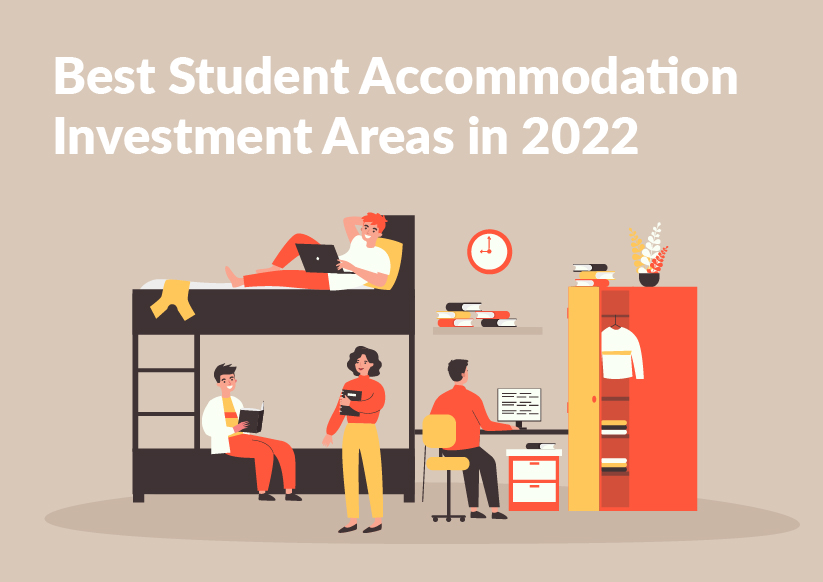Best Student Accommodation Investment Areas in 2023

In the past decade, student accommodation investment has been one of the fastest-growing property sectors. Both new and experienced investors can find highly profitable student properties, especially in the UK’s growing student housing investment hotspots.
Investors that choose student accommodation over residential properties tend to be income-driven, looking to gain the high rental yields that student properties can offer. But that’s not to say these landlords aren’t interested in long-term capital gains too, and plenty of areas across the UK offer the prospect of increasing property prices.
While there are some pitfalls to investing in student property, landlords that seek out properties with strong yields and areas with a steady stream of tenants can ensure that their investments remain profitable.
We take a look at some of the pros and cons of investing in student property and the best areas of the UK for student accommodation investment.
What are the Benefits of Investing in UK Student Property?
In recent years, student accommodation has been one of the best performing asset classes in the UK property market. Even during the 2020 – 2021 academic year at the height of the Covid pandemic, Purpose Built Student Accommodation (PBSA) saw growth of almost 2% – showing the sector has profitability and security.
While some areas of the UK did see occupancy rates hit due to the pandemic (London in particular as the city is overly reliant on overseas students), student accommodation investment has landlords looking past short-term challenges to see the long-term opportunity.
In the coming years, student numbers are projected to rise by 8.5 % and with purpose-built accommodation oversubscribed in many cities, student property has plenty of potential.
The current trend suggests that the student rental housing market is thriving and presents an excellent opportunity for investment in buy-to-let student accommodation. Despite the challenging market conditions experienced in the UK towards the end of 2022, investors are optimistic about expanding their portfolios now that the mortgage market has started to see a decline in interest rates.
There are a number of reasons why student property remains attractive to investors:
Higher Rents
Out of all the property classes, student property is known for offering some of the highest rental yields in the UK. Students tend to pay higher rents than standard buy-to-let tenants and by taking on multiple tenants that rent by the room, landlords can generate higher monthly income and yields. Well-run properties in the right areas can generate student accommodation investment yields of up to 20%.
For landlords, the higher rental yields can be a great way to increase their monthly income. Additionally, student property investments can be a great way for investors to diversify their portfolios. By investing in student accommodation, investors can benefit from lower risk than other types of property investments as well as potentially higher returns over time.
Cheaper Property Prices
Landlords can often secure student property for a lower price than other asset classes. Student properties are often located in areas that are cheaper to buy into, such as inner-city areas or close to campuses. Similarly, PBSA is often sold off-plan to investors, with developers offering the units at below-market rate.
This can be a great way for landlords to secure a good deal on a high-yielding property. Furthermore, the lower price of student accommodation makes it an attractive option for investors looking to increase their portfolio without breaking the bank.
Find out more about the benefits of investing in off-plan property).
Secure Tenant Demand
Student properties also tend to have a high demand, meaning that landlords are less likely to experience long void periods when the property is not occupied by tenants. Demand for student property tends to stay consistent year in year out. If a property is located in the right area and has appealing amenities, there is usually a steady stream of student tenants looking to rent the private accommodation.
In addition to this, student properties are often let on a joint tenancy basis. This means that if one tenant leaves the property, the remaining tenants are still liable for their rent and the tenancy agreement continues. This can be advantageous to landlords as it reduces the risk of void periods in comparison to an individual tenancy agreement.
Lower Risk Tenants
While there are risks associated with renting to students, they can be lower risk tenants too. Financially, students are likely to be backed up by student loans or by their families so you don’t need to rely on them taking a consistent monthly income.
Moreover, you can also ask them to provide a guarantor or a larger deposit if you’re worried about any potential damages. In addition, many students have a strong sense of responsibility and are more likely to take care of their rented property as they understand that their parents or guardians will be the ones paying for any damages.

What do you Need to Consider when Investing in Student Property?
While student accommodation offers plenty of opportunities, there are extra considerations landlords should take into account.
Void Periods
Student properties tend to be occupied from September to June, with tenants paying reduced or no rent over the summer. These void periods will mean that for a part of the year a student property may not generate any income. To offset this, it is important to ensure that rents are set at a rate which will generate enough income to cover all costs over the entire year.
Maintenance Costs
One of the main landlord concerns when renting to students is wear and tear on the property. Maintenance costs and wear and tear for student accommodation investment does tend to be higher when renting to students than with a regular tenant, and while most student tenants will take good care of a property, group gatherings and parties can be a regular occurrence. Landlords are likely to spend more on maintenance at the end of a tenancy than they would with a traditional let.
Higher Insurance
Due to the aforementioned higher chance of wear and tear, landlord insurance is likely to be higher for student property than for other property asset classes. The premium for student property insurance is likely to be higher due to the increased risk of damage, as well as the fact that students may not have the same level of financial responsibility as other tenants.
Extra Set up Costs
Landlords focusing on the student market may have extra licensing requirements and need planning consent if the property is an HMO (house of multiple occupancies). It is important to factor in these costs when looking at the potential return on investment.
It is also important to consider the cost of health and safety checks and any modifications that may need to be carried out in order for the property to meet HMO standards.
High Competition
Some student cities in the UK are reaching market saturation and students are spoilt for choice when it comes to accommodation. With an increase in Purpose Built Student Accommodation (PBSA) as well as a large amount of private accommodation on offer, some areas are seeing an oversupply.
Constrained Tenant Focus
As a student landlord, you can only sell student properties to students. As we saw with the Covid pandemic, when student lettings dropped, landlords can face potential challenges when they don’t have a wider range of potential tenants like families and young professionals to fall back on.
What Types of Student Accommodation are Available?
Student accommodation investment comes in various shapes and forms, but generally, there are two main types that investors need to consider. Understanding the benefits and drawbacks of each will help you to decide on a tenant market and the type of accommodation you want to focus on.
House of Multiple Occupancy (HMO)
Student property can be a similar set-up to a normal buy-to-let, where the property is rented between cohabiting friends or partners. In a student HMO, students rent a room individually and have their own tenancy agreement. HMOs are a popular form of property investment as landlords can usually achieve higher yields.
Getting an HMO Licence
A property is deemed an HMO if there are at least three tenants forming a household and sharing bathroom or kitchen facilities. When an HMO property has five tenants or more, it needs to meet certain standards and landlords have obligations in regards to bedroom sizes, fire safety measures and waste disposal. Landlords need to apply for HMO licensing every five years and failure to comply with HMO licensing regulations carries steep penalties.
Benefits and Drawbacks of HMOs
The upside to HMOs is that they tend to be cheaper to buy and come with a lower price point than PBSA. As landlords can rent out individual rooms to multiple tenants, if one tenant moves out, you still have income from the remaining tenants to fall back on.
HMOs tend to be more of a hands-on investment and unless the investor hires a property management company they’ll have to deal with ongoing tenant demands as well as any issues.

Purpose-Built Student Accommodation (PBSA)
The UK remains one the largest and most liquid PBSA markets in the world with transaction volumes of £6.1 billion in 2020. In the bigger student cities, PBSA is a popular option, especially among international students who are looking for property of a high standard.
The UK’s PBSA market has seen significant growth in recent years, with the number of purpose-built student accommodation units increasing by over 20% in the past five years. The demand for PBSA is expected to continue to rise, with an estimated two million students studying in the UK by 2025. With such high demand, investors are likely to benefit from a healthy rental yield and capital appreciation on their investments.
PBSA usually comes with building management and security meaning there are fewer things for investors to worry about, making them a better option for those looking for a hands-off investment. PBSAs tend to have a higher retention rate, too. They offer a sense of community and usually students will want to stay in the same accommodation throughout their studies.
Benefits and Drawbacks of PBSA
PBSA is generally built and designed to meet the demands of today’s student market. With modern design, layout and amenities, students are usually willing to pay a premium for this type of accommodation. Developments are usually built in prime locations in the city centre or close to campus, which increases the chance of high yields and capital growth.
PBSA is creating higher competition for landlords that own traditional student properties as some student accommodation can’t compete with the facilities and convenience offered by PBSA.
PBSA can come with some drawbacks. The first is that capital growth may not always be as strong as with residential property – but this depends on location and demand.
Secondly, there’s no option to get a mortgage on PBSAs, meaning they might not be a viable investment avenue for investors unable to pay the full cost upfront.

Tips for Investing in Student Property
What are some of the things to keep in mind when looking for a student property investment?
Focus on Location
While properties in the city centre do well because they are close to sought-after amenities, many students prefer to live within walking or biking distance to campus. If a property is further away from campus, ensure it has good access to public transport. If the local university is multi-campus, anywhere close to the campus could have strong potential.
Look into a University’s Popularity
Anyone looking to invest in student property should look into university league tables and student satisfaction tables. Taking note of the number of applications a university receives each year is also important.
Focus on Amenities
Many students are willing to pay a premium on properties with the right amenities. Those with larger rooms, ensuites, larger living and kitchens and garden or external space as well as higher-quality furniture allow landlords to charge higher monthly rent.
Focus on International Students
International students are more likely to want to live in private flats than domestic students. In general, international students tend to have higher expectations and seek accommodation that can make the move from abroad seamless. Many international students prefer to stay in the same accommodation for longer than a year and while home students may shop around for better rent, international students tend to stay loyal if the property meets their needs.
Get the Right Tenancy Agreement
Landlords need to decide whether they want to offer a single or shared tenancy agreement for their student accommodation investment. A shared tenancy agreement is ideal for friends renting a house together and can make things slightly easier for a landlord as the onus is on the tenants if someone leaves the property part-way through the academic year. A single tenancy is better if renting individual rooms to students who may not know one another.
In any tenancy agreement make sure to set out things like how damage to the property is dealt with and who is liable for things like unpaid rent and cleaning. A tenancy is a legal agreement between a landlord and tenants and you should seek out appropriate advice before drawing up any agreement.
Time it Right
The student market is cyclical and it’s important to time your investment right. You’ll need to allow enough time to undertake renovations and apply for any licenses after the completion of the sale. University terms start in September and it isn’t uncommon for students to begin house hunting from November onwards for the following term. If you badly time your investment, you could end up with an empty property for up to a year.
Meet Tenant Expectations
With competition increasing in the student market in many cities, tenants expect a higher standard when moving into privately rented accommodation after their first year.
Landlords need to provide good accommodation with quality furniture with decorations at a high standard.
All-inclusive properties are becoming increasingly popular because they give students peace of mind that costs are fixed. Usually, all-inclusive packages will include electricity, gas, water and contents insurance. Some may offer optional extras like broadband and streaming packages.
In addition to this, landlords should also ensure that the property is secure, with modern locks and alarm systems. Furthermore, the property should be in a good location, close to amenities and transport links. This will give tenants peace of mind that they can travel and access local shops with ease.

How the Pandemic has Impacted Student Accommodation
Student demand has undergone a slight shift in trends due to the pandemic. Large properties are more and more popular as students want to continue living with the people they shared halls with during lockdown as bonds and friendships got stronger. However, there is still a large part of the student market seeking out smaller apartments as they look to have their own space or to live with just one or two other people.
What Are the Best Areas for UK Student Property Investment 2023/24?
While the big student cities are always appealing to students and offer plenty of opportunities for student landlords, certain smaller towns have a lower proportion of PBSA, meaning lower competition. Regardless, here are some of the best cities for investing in student property in 2023/2024.
Liverpool
Home to a number of world-class universities, including The University of Liverpool, Liverpool John Moores University, Liverpool Hope University and Edge Hill University, Liverpool’s student market is thriving.
Each year Liverpool’s universities produce more than 30,000 graduates. With just 15,000 student beds, there’s strong demand for private rental property and investors can expect good returns thanks to the number of student tenants looking for quality accommodation. You can find premium student accommodation under £100,000 and with returns upwards of 8%. This makes it a great prospect for investment.
One of the best places to invest in student property for 2023 and into 2024, Liverpool already presents some of the highest residential yields in the UK, and investors can certainly capitalise on Liverpool’s growing popularity. When it comes to rental yields, student accommodation in Liverpool is one of the highest in the UK. With an average property price of £225,178 and an expected rental return of £18,569 a year on average, investors can benefit from yields of around 8%.

Manchester
Manchester is one of the best places to invest in property in the UK and a firm favourite with property investors. Home to five of the UK’s leading universities, Manchester is one of the most popular places to study for both domestic and international students. The University of Manchester consistently ranks in the world’s top 30 (QS World University Rankings) and is the UK’s largest single-campus university.
With around 99,000 students, demand for accommodation exceeds supply and there is a constant demand for student living spaces creating a solid buy-to-let student market. As well as with some of the highest numbers of international students, high standard accommodation with good amenities is in demand, too.
With popular student areas like Fallowfield and Disbury, landlords can find high yields, and Manchester comes in the top 20 for average potential yields in the UK.

Bristol
Bristol is now one of the best places to live in Britain. Additionally its population is experiencing high growth in recent years, growing 11.5% since 2007. As well as the University of Bristol, that ranks within the top 10 in the UK – the University of West England Bristol, University of Bath and Bath Spa put a large catchment of students within the city’s reach.
By 2028, Bristol will need an extra 6,800 student beds. As demand outstrips supply, now is a great time to invest in student property in Bristol, particularly as there is a significant shortage of purpose-built student property with just 13,000 units for 51,000 students.
Not only is there strong rental demand, but prices are at a premium. Two-bedroom flats in the prime university territory have an average rent of £1,000/month.

Leeds
The Leeds City Region hosts the largest cluster of higher education institutions outside London and each year its nine universities produce 38,900 graduates. The University of Leeds alone welcomes over 9,000 international students from more than 170 countries worldwide, and the number of students in the city continues to grow each year.
Due to the Covid pandemic, many students deferred their place at university by a year and 2022 saw an increasing number of students in the city. Leeds is one of the best student cities in the UK and already seeing a spike in demand for accommodation.
Homes within walking distance to campus in areas like Hyde Park, the city centre and Burley and Woodhouse are highly sought-after. Headingley remains a popular location for graduate students.

Birmingham
As the UK’s second-largest student city, Birmingham is home to five universities, including Aston, Birmingham City, the University of Birmingham, University College Birmingham and Newman University College and a total of 80,000 students.
Purpose-built student accommodation of quality is at a premium. Currently, there are only around 25,000 existing available student bed spaces in university-owned and privately owned accommodation. PBSA makes up 72% of beds in the market.
Despite the challenges presented by COVID-19, Birmingham achieved positive rental growth between 2019-20 and 2020-21. Ensuite rooms increased by 1.3% and studios by 2.9%. Birmingham is currently underserved by studios, which make up just 20% of beds in the market, which is low when compared to the UK average of 29%.
As one of the major student markets, Birmingham remains stable with rental growth remaining positive despite increasing levels of supply in student accommodation.
Is renting to students profitable?
Letting to students can be more profitable than other tenant demographics. Demand for student property is generally consistent meaning you always have a steady stream of tenants. Student property tends to deliver higher yields and because landlords can let out individual rooms to multiple tenants, yields can be anywhere between 8-20% for student property.
How do you run a successful student accommodation?
If you’re looking to buy student accommodation, becoming a successful student landlord begins with choosing the right property. Students tend to live in specific areas close to campus and within easy walking distance to amenities like transportation and shops as well as nightlife.
Landlords can maximise their income with HMOs, which allow them to rent the property to several students at a time who rent by the room. Many landlords convert reception rooms or dining rooms into bedrooms, adding an additional bedroom to the HMO and boosting rent. Remember to check whether you need a HMO licence.
__________________________________________________________________________________________
If you’re considering student accommodation investment, there are plenty of areas across the UK that offer the chance to make strong returns. While the pandemic did have an impact on student property, demand still outstrips supply and in the long-term student accommodation can be a worthwhile investment. To find out more about investing in student accommodation, get in touch with our team.



